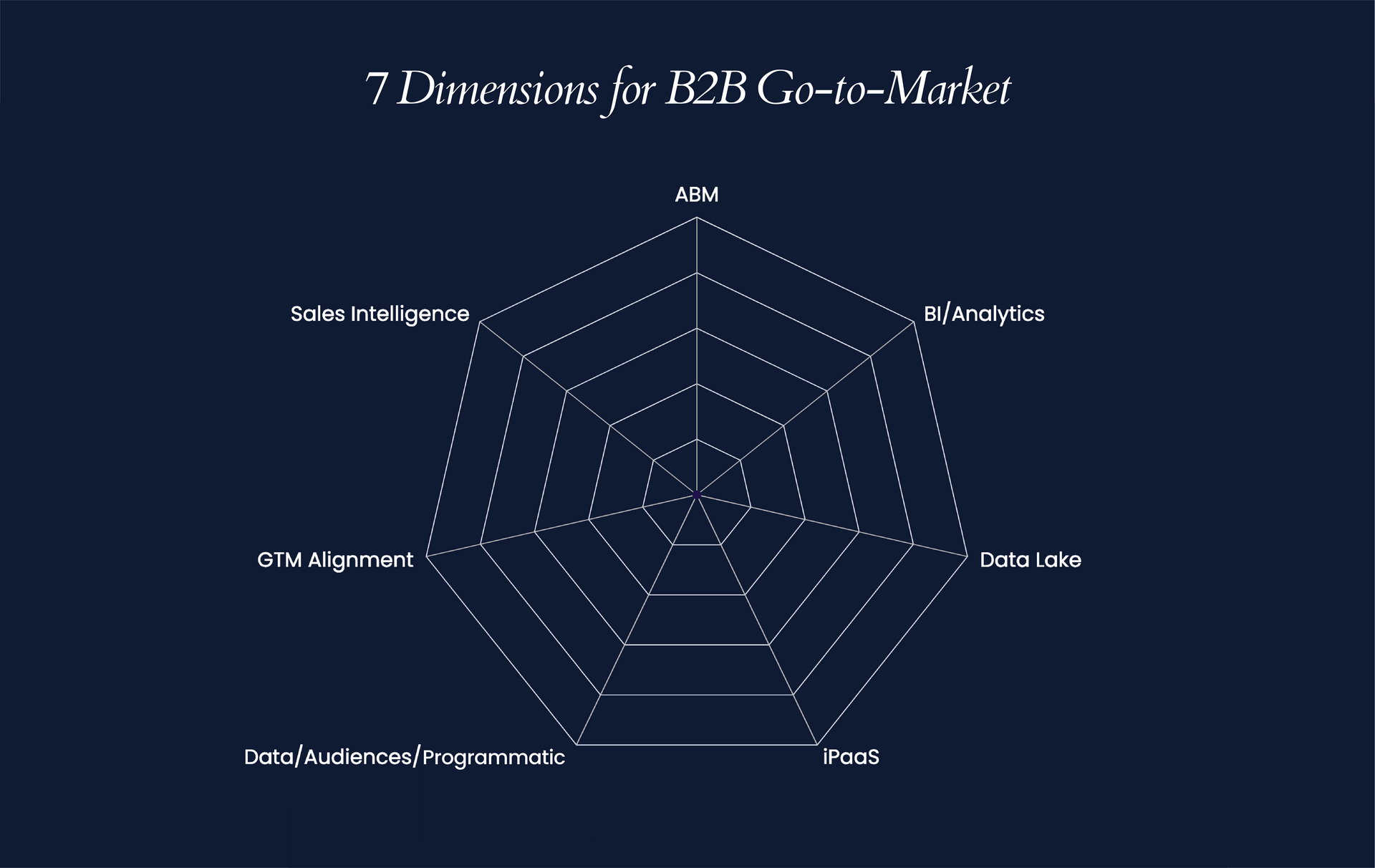
7 Dimensions for B2B Go-to-Market
About a year ago, we took our first steps here at Kwanzoo to go beyond just ABM as our focus, to assisting our customers, whether they were B2B SaaS Unicorns, or high growth B2B startups - to operationalize their entire B2B go-to-market process.
We were able to support them through a set of technology solutions and strategic services, right where B2B marketing meets Sales and Customer Success. We continued to focus on optimizing their entire buyer engagement process, from prospect-to-customer and more.
In the summer of last year, right in the midst of the pandemic, we made a significant investment in licensing a few key partner technologies. This has helped us accelerate our platform innovation, and deliver a whole range of new B2B go-to-market capabilities to our Customers. We are delighted to now introduce the new Kwanzoo Open Go-to-Market (GTM) platform!
Why Open GTM?
B2B CMOs and marketing teams today struggle with integrating 100s of Marketing, Sales, Success, Paid media and other platforms and tools into a cohesive, smoothly running Go-to-Market (GTM engine! It certainly does not help that most of their vendor partners have been building out solutions with a limited number of integration endpoints, or require that they push all data into Salesforce to generate any meaningful insights.
There is a complete lack of a common taxonomy, formats and standards that are open and easily available to operationalize across all their systems. Companies don’t necessarily want to “roll their own” integrations and connections across systems - where they would then have the ongoing costs and burden of maintaining yet more custom-built applications and tools in addition to all that they buy today from vendor partners!
What is Open GTM?
It’s an entirely new way of building up your enterprise tech stack, and operationalizing your B2B go-to-market process.

The 7 Dimensions to a Fully Operationalized B2B Go-to-Market
Here at Kwanzoo, as we work with some of the world’s fastest growing B2B SaaS Unicorns, we have developed a 7-Dimension Framework to categorize the GTM efforts of our Customers. We see the collaborative assessment with the Customer of the maturity of their technology, programs and execution capability in each dimension - as critical elements to establishing and operationalizing a highly effective and efficient go-to-market process for the Company as a whole.
GTM Alignment: Here we streamline how Customers capture and organize all their key GTM elements that today are spread across multiple “silo-ed” platforms and teams - from personas to buying groups, account lists to audiences, messaging by persona, product or industry, GTM goals for revenue and pipeline, and expected outcomes for each program or tactic. By defining all of these common elements upfront, it makes it a lot easier to align across all customer-facing teams - marketing, sales, success, paid media and more.
Data/Audiences/Programmatic: Achieving GTM goals requires access to the “fuel” that powers all of the company’s marketing, sales and customer engagement programs. Here we make sure that the Company has a clear understanding of their current state of data and audiences available, from accounts to contacts, for all key target segments to achieve their GTM objectives. With the coming deprecation of third party cookie support by leading Advertising ecosystems (Google, others) in 2023, it’s become imperative for B2B companies to develop a first party audience development strategy, to ensure they can have an ongoing conversation with the prospects and customers!

ABM: A critical element of B2B GTM today is a fully operationalized Account-based (ABM) data model along with the capability to define account-based segments. Companies need to be able to define the buying groups and personas at those accounts to target through a range of marketing programs, while surrounding them with relevant messages. These platforms additionally offer the ability to deploy Account-targeted display programs through programmatic channels, and collect all the key metrics across multiple channels (display, marketing & sales emails, website, 3rd party content syndication and more). Data and insights collected from both on-domain and off-domain (3rd party publisher) websites should reveal prospective buyer intent, which accounts sales should prioritize and pursue, and where marketing should “double down” on their outreach efforts and program investments.
iPaaS: Traditionally, iPaaS (or integration-platform-as-a-service) has been technology used in large enterprises by the IS / IT organization. However, with the proliferation of platforms, tools and tech across customer-facing teams, iPaaS is an increasingly critical capability for unifying critical data, standardizing / normalizing the data, and setting it up for further analysis and insights.
BI and Analytics: Trailblazing B2B SaaS companies realize that any one of their current infrastructure or platform vendors simply do not cover ALL of their critical data elements. And the pre-canned or pre-built dashboards and insights screens in those platforms often do not answer some of the most critical questions of interest to their GTM Leadership team. Thus it becomes essential to have BI & Analytics capability so key operational dashboards can be quickly customized to meet the specific needs for running the business.
Data Lake: High-growth B2B companies are generating large amounts of activity data every day, across their website, and from across their full range of marketing, sales and customer engagement programs. These programs are being run in-house, or outsourced to third party lead generation and content syndication partners, and are constantly evaluated, changed to reflect shifting GTM priorities, or updated market intelligence. These growing volumes of data need to be stored, analyzed, and used to generate insights on trends, find new ways to optimize program investments, or make lead and pipeline forecasts for upcoming months and quarters. All of this requires much more cost-effective storing and analysis using a Data Lake and related tools, as opposed to simply writing these large data sets into marketing automation or Salesforce CRM.
Sales Intelligence: Sales Development Reps (SDRs) and Enterprise sales reps (or Account executives) are always interested in better ways to prioritize and spend their time everyday on exactly the right accounts that are showing buying interest. They want to see complete account and buyer engagement journeys. For individual buyers, they want a complete view of all buyer behavior observed across any and all marketing and sales platforms and tools that have been used, whether in-house or outsourced, to reach and engage the prospective buyer.

Kwanzoo Open GTM goes well beyond today’s ABM platforms
Our new Open GTM platform has been designed and built to deliver on each of the 7 key dimensions for B2B go-to-market. We go well beyond today’s ABM platforms - and now provide entirely new capabilities, from GTM alignment to BI&Analytics, iPaaS to Data Lake - all in a single, integrated, B2B go-to-market solution. It’s all available at a very compelling single-platform price, thus making it a quick investment decision for B2B CMOs and Marketing Leaders.
Mani Iyer • March 3, 2022


